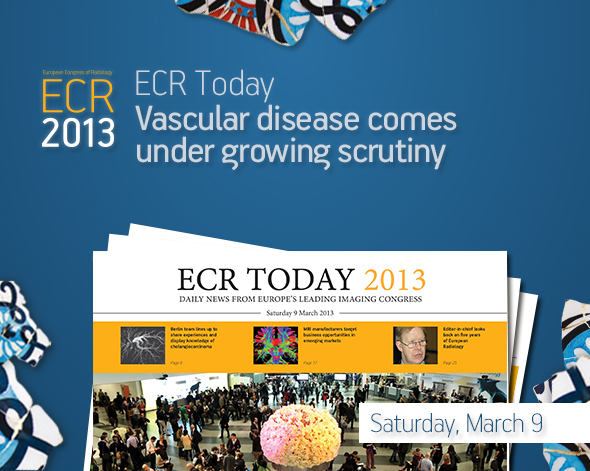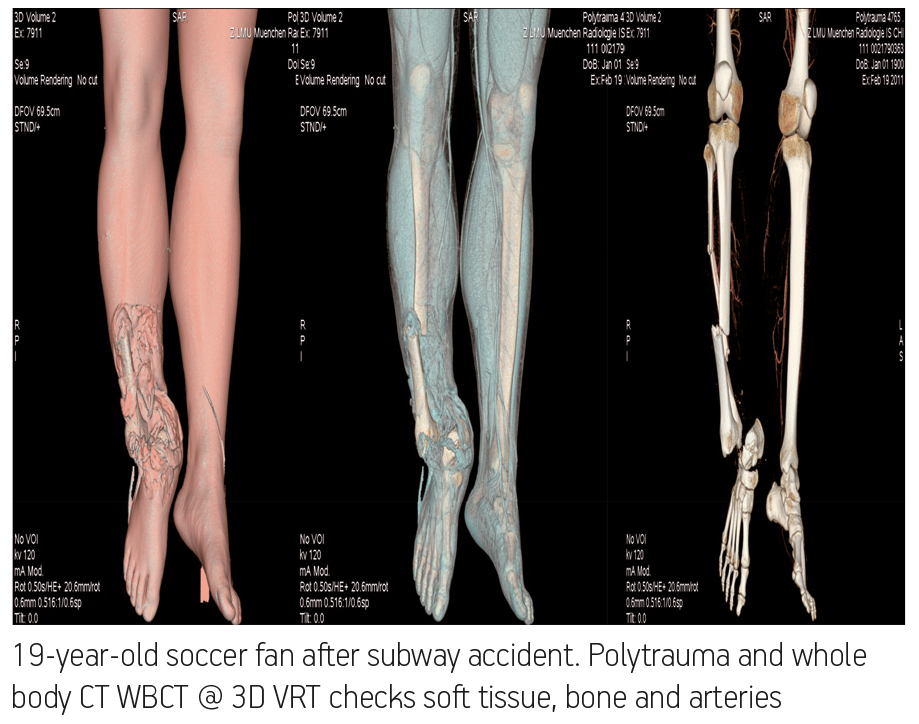
A-205 Can non-invasive techniques as CTA and MRA replace catheter angio for diagnostic work-up?
L. van den Hauwe, M. Voormolen, T. van der Zijden, R. Salgado, J. Van Goethem, P.M. Parizel | Saturday, March 9, 08:30 – 10:00 / Room B
Although catheter angiography remains the gold standard for cerebrovascular imaging, in recent years, it has been replaced to some extent by less-invasive techniques, such as CTA, MRA, and ultrasound. Some of these techniques allow for cerebrovascular imaging without exposure to ionizing radiation, and/or without requiring an exogenous contrast agent that could cause nephrotoxicity, allergic reaction, or other adverse effects. Moreover, all of these techniques avoid the extra time, expense, and possibility of complications that are associated with arterial catheterization. Ongoing developments in CT- and MR-based angiography continue to improve the effectiveness of these techniques, and to expand the clinical roles that they can fulfill. Nowadays, these noninvasive techniques not only provide images with high spatial resolution, but also offer time-resolved images, in which arterial and venous phases can be distinguished, and can provide selective visualization of vessels supplied by a single supplying artery. This presentation will review the latest developments in CT- and MR-based cerebral angiography, and illustrate the use of these CT- and MR-techniques in the diagnosis of cerebral aneurysms and vascular malformations.

B-0118 Determination of the vascular input function using magnitude or phase-based MRI: influence on dynamic contrast-enhanced MRI model parameters in carotid plaques
R.H.M. van Hoof, M.T.B. Truijman, E. Hermeling, R.J. van Oostenbrugge, R.J. van der Geest, M.J.A.P. Daemen, J.E. Wildberger, W.H. Backes, M.E. Kooi | Thursday, March 7, 10:30 – 12:00 / Room N/O
Purpose: A reliable vascular input function (VIF) is important for quantitative analysis of atherosclerotic carotid plaque microvasculature using dynamic contrast-enhanced (DCE) MRI. In tumour imaging and brain perfusion studies, it has been demonstrated that a phase-based VIF (ph-VIF) is less sensitive to flow artefacts compared to magnitude-based VIF (m-VIF). The purpose is (1) to compare m-VIF and ph-VIF and (2) to investigate the influence of different VIFs on DCE MRI model parameters in carotid plaques.
Methods and Materials: 21 patients with 30-99% carotid stenosis underwent 3 T DCE MRI. Data from four patients, scanned with a high temporal resolution were used to construct group-averaged m-VIF and ph-VIF of the jugular vein. The other 17 patients were used for calculating Ktrans (measure of plaque microvasculature) using m-VIF and ph-VIF. The effect of neglecting flow on the m-VIF was estimated using the Bloch equations.
Results: Peak concentrations of m-VIFs were on average 4-fold lower than for ph-VIFs (p<0.001). Despite these differences, strong and significant correlation between Ktrans determined using group averaged m-VIF and ph-VIF was found (Pearson’s correlation 0.91, p<0.001). Taking into account a theoretical flow of 8 cm/sec, the discrepancy in peak concentration of m-VIF and ph-VIF disappeared.
Conclusion: Our data suggest a strong influence of flow when calculating m-VIF of the jugular vein. Despite this, strong correlation between Ktransparameters determined using m-VIF and ph-VIF was found. It is expected that a phase-based VIF results in a quantitative more realistic value of Ktrans.

B-0120 Determining the vulnerable plaque: correlation between 18F-FDG PET and dynamic contrast-enhanced MRI in atherosclerotic plaques of symptomatic patients
M.T.B. Truijman, R.M. Kwee, R.H.M. van Hoof, R.J. van Oostenbrugge, W.H. Mess, J.E. Wildberger, W.H. Backes, J.A. Bucerius, M.E. Kooi | Thursday, March 7, 10:30 – 12:00 / Room N/O
Purpose: Identifying vulnerable atherosclerotic plaques in symptomatic patients with moderate (30-69%) carotid artery stenosis can contribute to clinical decision making. Hallmarks of plaque vulnerability are inflammation and increased neovascularisation. Inflammation can be assessed with 18F-FDG PET, while neovascularisation can be quantified with dynamic contrast-enhanced (DCE) MRI. We aimed to investigate the correlation between inflammation as assessed by18F-FDG PET and neovascularisation as assessed by DCE-MRI.
Methods and Materials: Fifty-eight patients with transient ischaemic attack (TIA) or minor stroke in the carotid territory and ipsilateral carotid plaque causing a moderate stenosis were included. All patients underwent 1.5 T multi-sequence MR imaging. Quantification of neovascularisation was done using a custom-made Matlab program which calculates Ktrans. A 3D PET-CT scan was performed on all patients one hour after injection of 2.75 MBq/kg body weight 18F-FDG. Dedicated fusion software was used to calculate mean blood-normalised 18F-FDG standard uptake values (SUV) of the plaque.
Results: Of the 58 patients, 9 were excluded due to poor image quality of the DCE-MRI. In total, we analysed 49 patients. The mean Ktrans and mean normalised SUV were 0.110 (±0.027) and 1.446 (±0.255), respectively. We found a weak but significant positive correlation between the mean normalised SUV and the meanKtrans (Spearman’s r=0.302, p=0.035).
Conclusion: There is a weak but significant positive correlation between Ktrans, which is a marker for neovascularisation and SUV, which is a marker for inflammation. Future studies are warranted to investigate whether DCE-MRI and/or 18F-FDG PET can be used to predict cerebrovascular events.

A-245 Pre-therapeutic radiological evaluation
J. Raupach, O. Renc, P. Hoffmann, J. Zizka; | Saturday, March 9, 08:30 – 10:00 / Room N/O
Endovascular abdominal aortic aneurysm repair (EVAR) was introduced over 20 years ago to primarily treat old and sick patients. Due to technical improvements and satisfactory clinical results of this technology, the number of patients treated with stent-grafts is steadily increasing. There is also tendency to use this therapy for ruptured abdominal aortic aneurysms. Pre-operative assessment of aortic morphology regarding suitability for stent-graft implantation is, therefore, an important challenge for every radiologist now. Main limitation of EVAR is unfavourable anatomy of landing zones and access vessels. Gold standard for EVAR planning is contrast-enhanced CTA. Alternative modality for patients with contraindications for CT, such as renal impairment, is unenhanced MR with steady-state free precession sequence. A number of 2D or 3D reconstructions are generated to provide information about the aneurysm morphology. Dedicated vessel analysis and planning software can be applied. Usually, axial images and thin MPR reconstructions are sufficient in emergent cases. Proper stent selection is a domain of operator and is still matter of his/her experience. The planning procedure can be subdivided into 4 different sections: infrarenal neck, aneurysmal sac, aortic bifurcation and access vessels. There are several critical and rules which must be obeyed during the evaluation process and general radiologists should be aware of. The presentation will review main inclusion and exclusion criteria for EVAR.

Watch sessions from this Categorical Course on ECR Live:
Imaging the arteries is a daily task for interventional radiologists like José Ignacio Bilbao, president of this year’s ECR, but other subspecialists should know about the main clinical problems associated with the blood vessels. The Clinical Lessons for Imaging Core Knowledge (CLICK) courses, starting this Saturday and finishing Monday, will present delegates with various clinical scenarios and state-of-the-art techniques for imaging vascular disease.
Cardiovascular events still account for the majority of deaths worldwide. Diabetes and hypertension are well-known risk factors that should be monitored and treated appropriately. But the combination of metabolic and cardiovascular factors should also be included in the equation, according to Lars Lönn, professor of vascular surgery and radiology at the National Hospital in Copenhagen. “Cardio-metabolic factors such as obesity are a major risk nowadays; for instance overweight people have a tendency to get fat in the liver, which also gives you a risk for diabetes,” said Lönn, who will chair the course, ‘How old are you in reality? Vascular age and clinical events,’ today at the ECR. Considering these factors is fundamental since the incidence of obesity will continue to rise in the near future, and with it the number of potential cardiovascular complications.

Read more…





